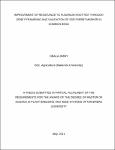| dc.description.abstract | Fusarium root rot caused by Fusarium solani f. sp. phaseoli is among the most serious diseases of
the common bean in Uganda causing total crop loss in susceptible cultivars. Studies have indicated
that 2-9 genes located at different loci govern resistance to Fusarium root rot among different
resistance sources. Accumulation of several of these genes from the different sources into a single
genetic background has been proposed to result in an increased level of resistance to Fusarium root
rot, and more effective transfer of this resistance into consumer-preferred cultivars. Use of
molecular markers together with phenotypic selection could speed up breeding progress for
Fusarium root rot resistance. A simple sequence repeat (SSR) PVBR87 marker linked to Fusarium
root rot resistance quantitative trait loci (QTL) was identified in a previous study but its use in
identifying resistant genotypes outside the original two mapping populations has not been
determined. This study estimated the number of pyramided Fusarium root rot resistance genes from
four sources of resistance, their interaction and effectiveness in improving Fusarium root rot
resistance levels. The study also validated the association of the SSR PVBR87 marker with
resistance to Fusarium root rot in an additional population.
The study was conducted at the International Centre for Tropical Agriculture (CIAT) based at the
National Agricultural Research Laboratories – Kawanda, Uganda. Four Fusarium root rot resistant
(R) inbred lines: MLB-48-89A (48), MLB-49-89A (49), G2333 (G2) and G685 (G6), and two
susceptible (S) lines: K20 and Kanyebwa (Kan) were used in the study. A double cross (DC) was
developed from the four resistant parents. The DC F1 and each resistant parent were crossed to the
two susceptible cultivars to form five-parent crosses and single crosses, respectively. Parental, F1
and F2 populations were subjected to Fusarium solani f. sp. phasoeli isolate-3. Twenty one days
xi
after planting, symptom severity was assessed on a scale of 1-9 (varied at 1,2,3,4,5,6,7,8,9). Plants
of each cross were grouped into resistant (score 1-4) and susceptible (score 5-9). F2 plants of K20 x
G2 and 49 x Kan were screened with SSR PVBR87 marker. The estimated number of genes and
gene interactions were determined using X2
goodness-of-fit test (P = 0.05) and means were
compared by “Students t-test” (P = 0.05). The association of SSR PVBR87 marker to Fusarium root
rot resistance was determined using X2
test of independence and single marker regression analysis
(P = 0.05).
Two to three genes segregated in the R x R single crosses and at least four genes segregated in the
double cross population indicating three of the four resistant parents differed from each other by at
least one gene and two of the four parents have at least one gene in common. Genetic effects among
the crosses included additive and dominance effects and epistatic interactions. Five-parent crosses
performed better than the single crosses, demonstrating the potential of using combined resistance in
improving resistance to Fusarium root rot in susceptible bean cultivars. The SSR PVBR87 marker
showed significant association to Fusarium root rot resistance in both K20 x G2 and Kan x 49
indicating its stability in different genetic background but still requires further validation in different
environments and in additional genetic backgrounds to determine its use for marker-assisted
breeding for improving resistance to Fusarium root rot.
The genes responsible for the higher levels of Fusarium root rot resistance in the pyramids are not
specifically known. It is necessary that these resistance genes be tagged with molecular markers.
Tagging of the genes with molecular markers would provide knowledge of their genomic locations,
the nature of their interactions and also facilitate the transfer of these genes or alleles, through
molecular marker-assisted gene introgression, into other agronomically superior, but Fusarium root
xii
rot susceptible cultivars. Since no selection for Fusarium root rot resistance or any other desirable
agronomic traits was practiced in this study, there is need to select between and within families from
among the five-parent cross populations and the single crosses for resistance to Fusarium root rot.
However, the predominance of non-additive gene effects for Fusarium root rot resistance, especially
in the five-parent crosses suggests that selection for resistance would be more effective at advanced
generations of selfing. The bean parents used in constructing the five-parent cross populations are of
diverse seed character, growth habit, maturity period, and have varied response to several abiotic
and biotic constraints. There is also need to select for these traits in the populations developed in this
study as these traits eventually affect acceptability of any potential new variety. The amounts of
phenotypic variation explained by the SSR PVBR87 in two populations were low; hence, there is
still need to further validate the marker in additional populations and in several environments to
determine its efficacy for marker-assisted breeding for Fusarium root rot resistance | en_US |

